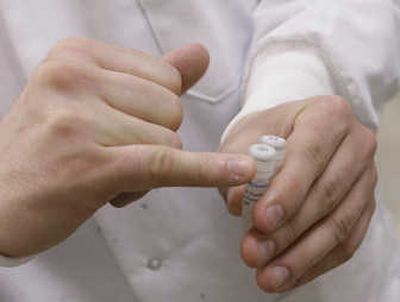DNA suggests pattern of ancient migration

Brian Kemp learned a lot from one 10,300-year-old tooth.
The Washington State University researcher has identified a previously unknown pattern of relationships among Native Americans – suggesting that humans arrived here more recently than previously believed and migrated down the western coastline from Alaska to the tip of South America. His finding suggests that ancient teeth might become a wider source of discoveries about historical DNA and unlocking more information about the past.
“We learned something that we would have never known, and it’s important now that we start studying teeth,” said Kemp, a molecular anthropologist who did the research as part of a team while finishing his doctoral work at the University of California, Davis.
Kemp’s research on the tooth discovered in Alaska’s On Your Knees Cave was dubbed one of the 100 top science stories of 2007 by Discover magazine. It was the oldest human genetic sample from the Americas ever analyzed; most DNA doesn’t survive a few hundred years, let alone thousands.
“Ten thousand years is a long time, and that’s why the sample is so important,” Kemp said. “I’ve worked on 500-year-old samples that have no DNA.”
He was one of two WSU researchers on the Discover list. The other was Michael Skinner, who made the top 100 once before for research showing that when pregnant mammals were exposed to a common fungicide, their descendents suffered disease and other health effects for several generations. That single exposure creates “epigenetic” additions to the DNA of the exposed mammal and its descendents.
Most recently, Skinner has shown that the male descendents of rats exposed to toxins become less attractive to females even if they’re not sick – meaning that pollution can affect not only the DNA of a family for generations, but the overall development of a species, Skinner said in a news release.
“This is one of the first experimental studies to support a role for epigenetics in evolutionary biology,” he said. “We showed that epigenetic changes can modify sexual selection in such a way as to influence the evolution of a species.”
Kemp, who started working at WSU in the fall, has done a lot of work searching for DNA in skeletal remains – including analyzing bones from apparent mass Aztec sacrifices. As part of the team at UC-Davis, he’d looked for DNA in other bones found in On Your Knees Cave on Prince of Wales Island in 1996, but hadn’t found any genetic material.
But when he tested a tooth, “it worked and it worked amazingly,” he said.
Discover called the find “genetic gold.”
It’s not entirely clear why fragments of DNA survive in some bones and not others. Having a steadily cool and dry environment, like a cave, helps.
When Kemp looked at the sequence of DNA from the sample, he found a pattern of mutations that matched one of five known genetic types associated with Native Americans. But he also found another pattern of mutations that he’d never seen before. When he compared it with all the other samples of Native American genetic material available, he found the pattern in about 1.5 percent of the samples.
Most of those samples had come from coastal areas, from Alaska all the way down to Tierra del Fuego, at the tip of South America. The analysis of the DNA also suggested that people had first arrived in the Americas much more recently than previously believed – about 15,000 years ago instead of 40,000 – and migrated south along the coast. Among those samples, the relationship between people living in Alaska and Peru, for example, was closer than that between coastal and inland Native Americans.
Kemp said that makes sense, given that the skills necessary for coastal living would be similar even in different parts of the world.
“If you know how to live on the coast in Alaska, you know how to live on the coast in Mexico,” he said.
Kemp said the discovery suggests the possibility that teeth could be good sources of ancient DNA.
That’s important because other methods of archeological research couldn’t have turned this up, he said – studying artifacts would not suggest the extent of the relationship or migration.
But teeth are highly prized by scientists in a lot of fields, because they reveal information about people’s growth and habits, and it’s sometimes difficult to get them for DNA testing, which is destructive.
As part of his research, Kemp looks for DNA in other places, too. Another good source of very old genetic material is desiccated fecal matter preserved in caves.
“I’m at work on a number of really old fecal samples right now,” he said.